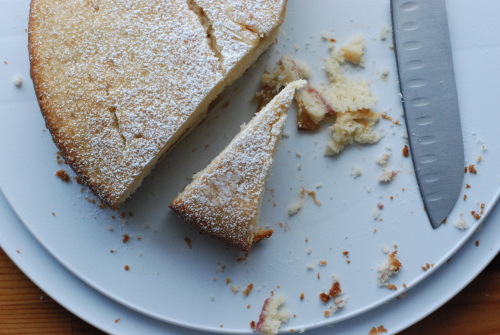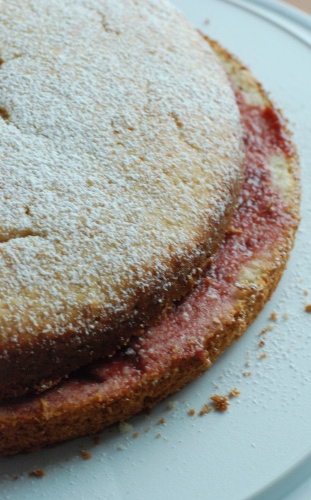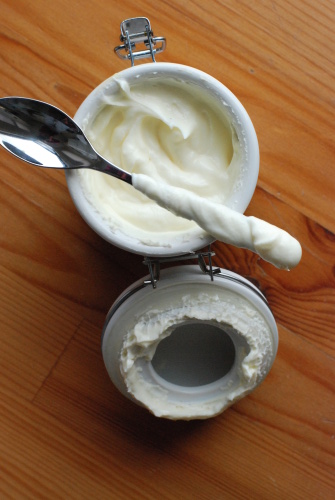 In my minds eye, a good cake is at least two layers high. It's fluffy and moist and laden with chocolate and, if I'm lucky, coated from head to toe and all in between with cream cheese frosting. Or better yet, chocolate cream cheese frosting. In a word, decadent.
In my minds eye, a good cake is at least two layers high. It's fluffy and moist and laden with chocolate and, if I'm lucky, coated from head to toe and all in between with cream cheese frosting. Or better yet, chocolate cream cheese frosting. In a word, decadent.
It's easy to pass up simpler cakes in favor of the sky-high versions I make for birthdays and such. But when a more casual occasion comes along and I have good reason to make a cake that's not coated in frosting, I jump at the chance. Much like the toasted flour sables I made in my last post, this cake is very girl-next-door. It's the epitome of rustic simplicity, a simple batter flavored with just buttermilk and vanilla. The resulting cake is clean and pure, its texture at once moist and airy. It's a cake made for brunch or a picnic in the park. A slice would also be the perfect accompaniment to a cup of tea, which is a ritual for me on winter mornings.

Oops! I've gotta let you know where this cake is from: it's Rose Levy Beranbaum's brainchild, in her genius bakebook The Cake Bible. If there's one thing I've gleaned from poring through the book these past two weeks, it's that Beranbaum's cakes are fundamentally different than most I've made before. Instead of creaming the butter and sugar together and subsequently adding the dry ingredients, this cake starts with flour, sugar, salt, and leavening agents. Butter and buttermilk are added after that, and the mixture is beaten for 3 minutes to "aerate the cake's structure." It seemed a bit odd at first -- especially when my batter was so thick that aerating seemed out of the question -- I dutifully followed her instructions anyway, and the cake came out perfect.
I brought my buttermilk country cake to an engagement brunch for my good friends R and K. I'd planned to top it with some baked sliced apples, but I ended up changing the plan a little: see, it was pretty hot in my kitchen and the butter holding the ring of parchment paper to the base of the pan had melted, so the paper kept curling at the edges. I'd already made the baked apple slices, so I laid them out in a spiral pattern on top of the parchment paper to hold it down, then poured the batter overtop. I considered serving it upside down to show off the fruit, but the top of the cake had formed such a lovely crust that I left the apples underneath as a surprise. I also had some concord grape puree I'd made a couple weeks ago when grapes were available at the market, so I sliced the cake into two layers and spread the grape preserve in between.

I'd intended to serve it with homemade creme fraiche(!) -- another super easy recipe from The Cake Bible -- but it hadn't quite set in time for brunch. Back at home, I sampled a slice with the creme fraiche, you know, just to make sure I wasn't misguiding my readers. Boy did I lick that plate clean.
Ruth Levy Beranbaum's Buttermilk Country Cake
4 large egg yolks (I used 2 eggs instead) 2/3 cup buttermilk 1 1/2 teaspoons vanilla 2 cups sifted cake flour 1 cup sugar 1 tablespoon baking powder 1/2 teaspoon salt 8 tablespoons unsalted butter (softened)
Preheat oven to 350 degrees. Butter a 9"x2" springform pan; line the pan's bottom with a disk of parchment paper, then butter and flour the entire pan, shaking out the excess flour.
In a medium bowl, combine the yolks (or eggs), about 1/4 of the buttermilk, and the vanilla.
In the bowl of a stand mixer fitted with a paddle attachment, combine all dry ingredients and mix on low for 30 seconds. Add the butter and the remaining buttermilk and continue to mix until everything is moistened. Increase to medium speed and beat for 1 1/2 minutes. (This is where Beranbaum says you're "aerating the structure of the dough." Mine felt more like bread dough and less like cake batter, but given that the cake came out very tasty, I think it's supposed to be this way.) Scrape down the sides of the bowl, then begin gradually adding the egg mixture in 3 batches, beating for 20 seconds after each addition. Scrape down the sides once more.
Pour batter into a prepared 9" in prepared pan and smooth the top. Bake for 30 - 40 minutes (mine baked 35), until a toothpick comes out clean and the center springs back when pressed. The edges aren't supposed to pull away from the pan until it is removed from the oven.
Let the cake cool still in the pan on a rack for 10 minutes. Then slide a knife around the perimeter of the cake to loosen it from the pan, and carefully remove the cake by flipping it onto the rack upside down. Immediately flip it back onto a plate or cake stand -- you need to store it rightside up so it doesn't break.
To serve, simply dust with powdered sugar and top with a dallop of whipped cream or creme fraiche. Fresh fruit would also be lovely -- Beranbaum recommends peaches.
Homemade Creme Fraiche adapted from The Cake Bible
1 cup heavy cream 1 tablespoon buttermilk sugar to taste
In a jar or container with a tight-fitting lid, mix the cream and buttermilk, and stir to combine. Close tightly and set in a warm place (I used the top of my stove). The buttermilk will take at least 12 hours to do its job, possibly up to 24; for ultra-pasteurized cream, Beranbaum says it could take as many as 36 hours. Be patient. You're aiming for a very thick product; Beranbaum says it should be pourable, but I wanted it thicker so I left it for 24 hours even though it had thickened after 12. Once thick, transfer to the refrigerator until ready to serve.
When you first open the jar, you'll see that the cream smells strong and sour. Don't mistake that smell for spoilage -- it's just the bacteria doing their job, as in homemade yogurt. The smell will fade almost completely after the creme fraiche is refrigerated.
When you're ready to serve the creme fraiche, stir in a teaspoon or so of sugar. Taste and adjust; I wanted mine pretty sweet, so I used 1.5 teaspoons. Beranbaum recommends whipping the creme fraiche until soft peaks form, but like I said, mine was the texture of cream cheese frosting and didn't need to be refrigerated.